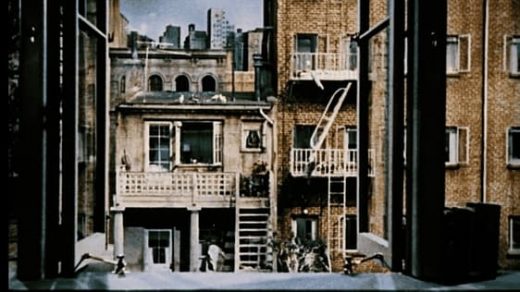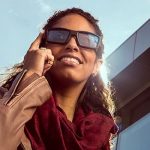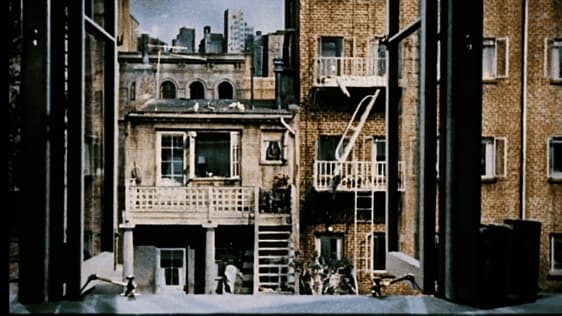Alfred Hitchcock Was A VR Pioneer
Most people know Alfred Hitchcock as Hollywood’s Master of Suspense. Fewer people know that Hitchcock was also a life-long innovator who experimented with a number of formal cinematic techniques, from making a movie seemingly in one continuous take, as he did in 1948’s Rope, to the pioneering stereoscopic methods he used for 1954’s 3-D Dial M for Murder.
But his most interesting experiment, especially for contemporary storytellers taking on the challenge of VR, is the mystery thriller he released later in 1954, Rear Window.
In Rear Window, Hitchcock’s experiment was to tell a complex story from a single, fixed perspective. The perspective is that of the temporarily immobilized L.B. “Jeff” Jeffries, confined to his apartment by a broken leg sustained while taking a spectacular photograph of an oncoming racing car, mid-smash.
In Hitchcock’s experiment the camera is never allowed to roam beyond Jeff’s apartment nor to see anything that Jeff could not have seen, so long as he is awake and looking in the right direction. In this way Hitchcock pre-empted the fixed perspective of the VR viewer.
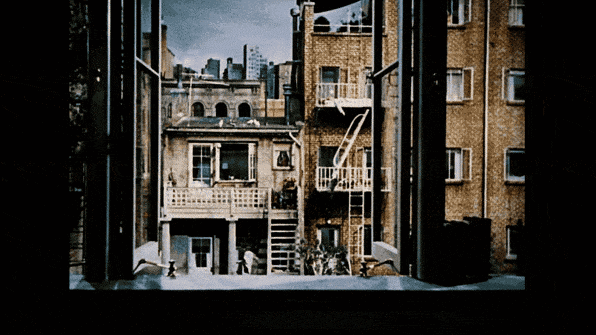
Being Hitchcock, obviously he couldn’t resist including a murder mystery, so the conditions for two of the great director’s personal obsessions are perfectly met: a taut, suspense-filled narrative, and a story that turns all of us, both characters and audience, into unwitting voyeurs.
So how does Hitchcock go about telling his story within these limitations? Hitchcock’s method is both ingenious and charming. He creates a number of parallel stories that are interwoven, allowing him to explore the real subject of his story: marriage, its frustrations and its consolations.
The central story–Jeff (Jimmy Stewart) and Lisa (Grace Kelly) wrangle over the question of marriage (she wants to, he doesn’t)–is illuminated by the parallel narratives that play out across the courtyard, all within sight of Jeff’s apartment.
The newlyweds, too “busy” in the bedroom to ever see the light of day, “Miss Lonelyheart” the unhappy singleton, the popular “Miss Torso” and her many admirers and, of course, the salesman and his bed-bound wife, whose tortured relationship becomes the focus of sinister speculation.
Crucially, these parallel stories require us, as well as Jeff and Lisa, to be observers–and central to this method of storytelling is the interpretation, and reinterpretation, of what we see, or think we have seen. The intrigue, and to a certain extent the suspense, is created by the continuing question of whether what we’ve observed means what we think it means.
But more than that, a complex and evolving subtext to the story is created by the way the things we observe parallel, and comment on, the central dilemma of the protagonist.
So, using nothing more than a fixed perspective camera (with, perhaps, a little help from the most expensive Hollywood studio set built to date), the director can tell a compelling narrative, with parallel sub-plots, each of which comments on and informs the main story, Hitchcock’s own wry contemplation of marriage.
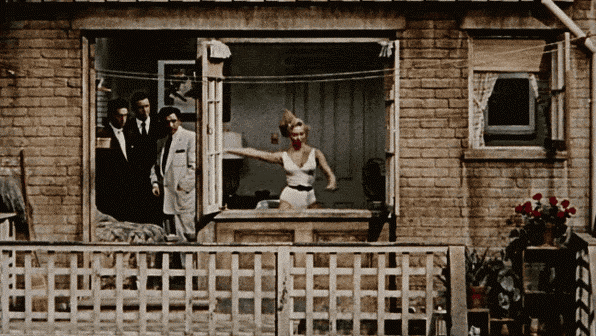
A Secret, Private World You’re Looking Into
In the past few years, many of the problems of storytelling in VR have been attributed to the way cinematic storytelling techniques do not automatically transfer to virtual reality. But Rear Window shows us that doesn’t have to be the case.
As we have seen, Hitchcock’s story demonstrates that a fixed perspective is not necessarily a barrier to creating a subtle and compelling story–although, of course, it inevitably results in the action feeling a little more theatrical than cinematic.
But Hitchcock’s pre-emptive VR experiment goes further than that. Once the camera is so identified with a single perspective, the inherent voyeurism of cinema becomes more apparent—and, in fact, becomes a theme in Hitchcock’s story itself.
The development of cinema (which Hitchcock himself had significantly influenced) turned audiences into unwitting voyeurs. From the comfort of our cinema seat, hidden in the dark, we occupy a privileged position, where we can observe all sorts of things that we wouldn’t otherwise see.
However, it’s uncomfortable to be reminded of that. “That’s a secret, private world you’re looking into out there,” the sardonic lieutenant Doyle reminds us in Rear Window. “People do a lot of things in private they couldn’t possibly explain in public.”
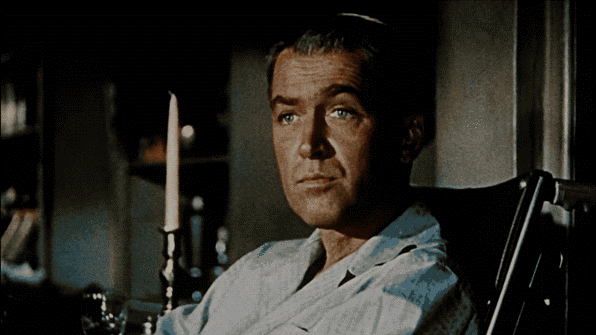
But of course we know, as conditioned cinema goers, seeing things we maybe shouldn’t see is where all the fun is. And as an audience, we also know that Hitchcock is always on the side of the snoopers (and never, ever on the side of the policeman). How could he not be? He devoted a career to dramatizing private acts, exposing them to public, even prurient, view.
So can VR create the same privileged view, and does it? The explicit positioning of a viewer in the actual scene is VR’s most powerful innovation. But that innovation also rudely disappoints anyone expecting to sit in the same anonymous comfort as the cinema viewer.
Once you feel that you are present in the scene, all sorts of other feelings are activated, from exhilaration, to self-consciousness, to that sweaty prickle of guilt, which is pretty much exactly what Jeff feels when he realizes that his over-active curiosity has turned him into some kind of peeping Tom.
But even that troubling feeling can be exploited in the service of Hitchcock’s story. Perhaps the most dramatic scene in the film includes the moment the suspected murderer, Lars Thorwald, sees that Lisa is signaling across the courtyard. His gaze moves slowly from Lisa, following where she is gesturing, until he is looking directly into the camera, at Jeff–but also, because we share Jeff’s perspective, directly at . . . us.
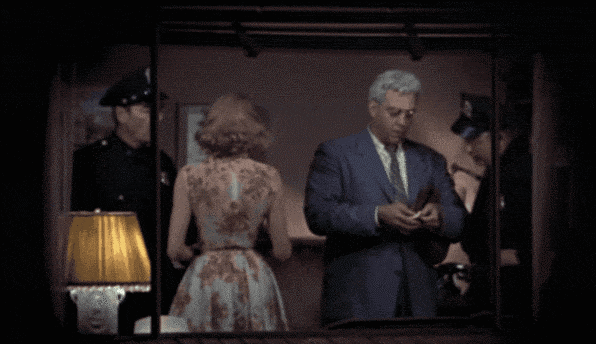
That moment is shocking, not just because we feel threatened, but also because we feel guilt at being discovered, caught, implicated in the scene. Once the presence of the viewer is acknowledged, their powerlessness to intervene in the action (whether separated by a few feet or the width of a courtyard), can dramatically be very powerful.
And the suspense has the greatest dramatic force only when the characters on “our” side of the courtyard cross the divide, passing through a (quite literal) “fourth wall” to enter the stage.
Years later, Hitchcock chuckled with pride as he boasted that, during the movie’s premiere, the tension was so great that actor Joseph Cotten’s wife, seeing Thorwald returning to his apartment while Lisa is still inside, grabbed him in the theater and demanded he do something to save her.
Hitchcock had not only discovered what in VR is now called “the Swayze effect,” he was already using it to raise his audiences’ blood pressure.
The lesson for VR is that Hitchcock draws the audience into the action–not by creating a facsimile of presence but through the story.
So, if a fixed perspective can be so powerful, why didn’t Hitchcock choose to tell the story only through Jeff’s eyes?
A few years before Rear Window, in 1947, Robert Montgomery shot The Lady in the Lake as a first-person experience—that is, with the camera taking the place of the protagonist. Hitchcock was less than complimentary about his fellow director’s experiment: “Young directors always come up with the idea, ‘Let the camera be someone and let it move as though it’s the person . . . ‘ Bob Montgomery did that in Lady in the Lake. It’s a terrible mistake. What are you really doing? You are keeping back from the audience who it is. What for?”
What Hitchcock instinctively understood was that a first-person camera, far from being more immersive, actually pulls an audience out of a story–because it creates a mystery. Who is the character behind the lens? Why are they hidden? The audience inevitably starts asking unwelcome, story-driven questions.
Or put another way, a first-person camera might be more immersive as an experience, but it is actually less immersive as a storytelling device.
It inhibits the fundamental mechanism that creates identification with a character. Not literal identification, where our view is the character’s view, but story identification, which is the basis of empathy and is therefore fundamental to storytelling.
Put crudely, as a viewer, you can’t empathize with yourself.
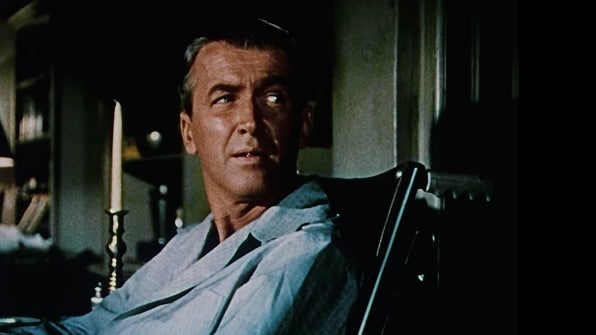
VR For Storytelling, And The “Kuleshov Effect”
Not content with his experiment in fixed-perspective storytelling, and a bit of mischievous toying with his audiences’ own guilty voyeuristic pleasure, in Rear Window, Hitchcock was also subtly experimenting with another famous cinematic idea: the “Kuleshov effect.”
This basic editing principle is well known: Whenever you cut from an event to a character reacting, an audience will interpret the appropriate reaction. If you cut from a roast ham, the reaction looks like hunger; if you cut from a snake, the same reaction looks like fear.
In Rear Window, Stewart’s reactions are fundamental to creating the meaning of the story. And when Stewart saw the final edit, he was surprised at how many of his reactions Hitchcock had cut into completely different parts of the story. Hitchcock was acutely aware of the power of reaction shots in creating story. In fact, he went further, often dismissing the words the actors spoke as just another element of sound design.
“Dialogue should simply be a sound among sounds, just something that comes out of the mouths of people whose eyes tell the story in visual terms,” he told Director François Truffaut.
Observation, reaction, interpretation, empathy: These are the fundamental building blocks of visual storytelling.
When seen in the context of VR, perhaps Hitchcock’s different experiments in Rear Window actually reveal something more about the nature of visual storytelling. What cinema is able to create is a merging of the subjective with the objective. We can inhabit a character via our imagination, not because we physically occupy their point of view, but because we can identify our own point of view with theirs, temporarily, thereby gaining an understanding of them as a character. That is something that is both compelling and deeply seductive as an experience.
It is in the unconscious join between shot and reaction that we as viewers are able to find ourselves both as subjective and objective observers. We are able to both imagine what a character is feeling, and feel it for ourselves. In other words, to get the full story, we need an action and a reaction—a shot and a countershot.
That is the basis of cinema’s power as a storytelling medium. And it is also the challenge for VR storytelling. VR must rise to that challenge if it’s going to become a true storytelling medium, and establish the same grip on our imagination as a piece of cinema like Rear Window has for the past 60 years.
Henry Trotter, @MrHenryTrotter, is an award-winning writer and director. For the past four years he has been working with leading visual effects, animation, and pioneering VR studio Framestore, which explores the possibilities for visual storytelling created by innovative new technologies.
(33)

